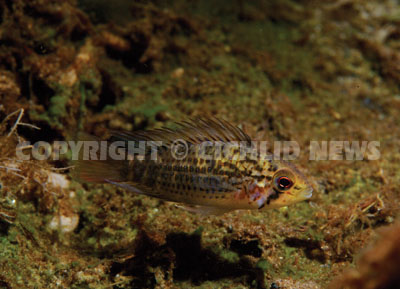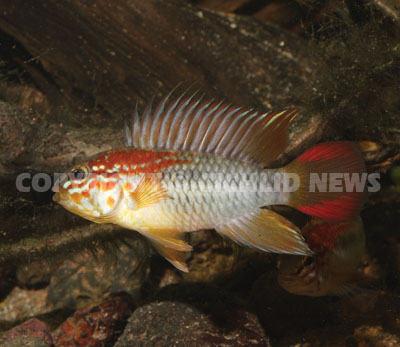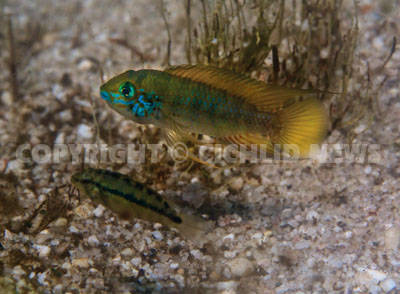 |
Cichlids of the Middle Orinoco Related to Apistogramma macmasteri — A Closer Look
by Oliver Lucanus
|
Fish come and go in the hobby, largely because only few species have a steady supply from their point of origin. Breeders usually take great care not to cross species, and keep offspring as close to the original stock as possible. Others seek to modify the wild fish, and breed them to increase the color of the young. This is often achieved by crossing species, or selecting the most colorful individuals. Unfortunately the elegance and natural beauty of the wild ancestors is often lost in the process.
The deep bodied Apistogramma species of the A. macmasteri group are among the most beautiful dwarf cichlids and well worth a closer look. This year (2014) marks the first wild imports of A. viejita in over 20 years, and finally this species’ wild form is available to our hobby again. All of these Apisto species require aquariums of around 1 meter (3.3 ft) in length, and plenty of ground cover to reduce the aggression of the adult males. They can easily be kept with small tetras, Corydoras catfish species, and other small fishes from this region. If the aquarium is not too crowded they should be able to breed and raise some of the fry in such a community setting.
|

|
Apistogramma hongsloi in its natural habitat near Puerto Gaitan, Rio Meta drainage.
|
|
A. hoignei, A. viejita, and A. hongsloi are tied to Moriche palm swamps and lagoons, called “Morichales”. These usually carry slow moving, clear water from higher elevations towards the Rio Meta. The habitat is shared with tetras (including neon tetras and rummy nose), juveniles of larger fish that enter the flooded Llanos (the flood zone plains of the Rio Orinoco) in the dry season, Mikrogeophagus ramirezi, and medium-sized predatory species.
Apistogramma guttata
A. guttata is found in the Rio Morichal Largo and the Rio Orinoco Delta, in slow moving black or clear water rivers. The remote location and current export situation in Venezuela, means that there have not been any recent exports of this species from this area.
|

|
Apistogramma guttata in its natural habitat in the Rio Orinoco drainage, Venezuela.
|
|
Apistogramma nororientalis
The Rio Uracoa in the Orinoco Delta region is home to this species, which has not been exported for the aquarium trade until now. The species is similar to A. guttata.
Apistogramma penduculata
This species has been described recently from the Rio Caura basin in Venezuela; it is similar to A. hoignei. Until now, the species has not been exported.
Apistogramma hoignei
This species is found north of the Rio Meta, in the tributaries of the Rio Apure, in the same habitat as A. viejita and A. hongsloi. The very robust males need some extra space to form their territory, and females should have plenty of hiding places in the form of plants or leaf litter along the bottom. Small, hollow spaces are ideal since the much larger males are not able to follow the females into them. A. hoignei may show some extensions on the end of the caudal fin, with or without red stripes.
|

|
Apistogramma hoignei from the Rio Meta drainage.
|
|
Apistogramma viejita
Horst Linke’s iconic A. viejita photos show spectacular wild fish, that have been absent from the hobby for 20 years, and have been much talked about ever since. While captive-raised A. viejita are nice red colored dwarf cichlids, they do not really represent the actual coloration of this species. Likely they were crossed with A. macmasteri at one point to increase the red coloration. The two species are strikingly similar, and their habitats overlap in some areas.
|

|
Two Apistogramma viejita wild form males fighting.
|
|
This year’s imported wild fish very much resembles Linke’s ‘Morph 1’, but some individuals also show the red-spotting on the gill cover similar to ‘Morph 2’. It is likely that this variance means the morphs are not separated by location, but may just be color variations within the population. In some locations the species may occur with A. macmasteri. Males of both species have the red bars in the caudal fin, but A. viejita has a much smaller black spot on the caudal peduncle. The distribution of A. viejita is in the Morichales along the Rio Meta, between Puerto Lopez and Puerto Gaitan.
|

|
A wild form male and female Apistogramma viejita.
|
|
|
|

|
The A. viejita’s “man-made” aquarium strain. Compare coloration to above.
|
|
Apistogramma hongsloi
The “Rotstrich” (German for “red stripe”) Apistogramma is also found along the Rio Meta and south to the Rio Vichada, in the same kind of habitat as A. viejita, but east of Puerto Gaitan and down to the Rio Orinoco, spreading to the other side into Venezuela. The wild form of A. hongsloi is a very attractive fish, even if it lacks the amount of intense red coloration of the captive-raised forms. The overall yellow body color of males from around Puerto Gaitan is different from other species in the group. The caudal fin lacks the two red bars.
|

|
Two aquarium strain males Apistogramma hongsloi.
|
|
Apistogramma macmasteri
This fish was once common in the hobby, but with the conflict in Colombia, the road along the Andes from Villavicencio was then less traveled, and exporters collecting this region simply stopped catching this species. A. macmasteri is found in a number of small streams leading from the eastern Cordillera out into the Llanos, at times coming very close to the Andes where water is cooler than in the Llanos region, in the upper Rio Meta and Guaviare. The species is found together with various Corydoras species, Astyanax tetras, Ancistrus catfish, and even Andinoacara cichlid species. The northeastern part of the range extends into the Llanos and A. macmasteri and A. viejita can occur in the same habitat.
|

|
Apistogramma macmasteri in its natural habitat, near Acacias, Rio Ariari.
|
|
Apistogramma alacrina
Further southwest of the Rio Ariari, the Andes are separated by a small lowland area near the Sierra de La Macarena mountain range, in the Rio Guejar and Rio Guaviare drainage. Once part of the Guyana Shield (before the present day Orinoco was formed) this solitary mountain range sits, unrelated to the nearby Andes, like an island in the Llanos lowlands. The small streams along the eastern slope are the home of A. alacrina. The species occurs here, often in cooler water, and can even feel at home in fast moving rapids, living among Chaetostoma and Ancistrus catfish, and other species generally associated with these habitats. The species was imported as “Rotpunkt” (German for “red dot”) Apistogramma, and has been exported on a regular basis in recent years. In higher water temperatures, this species can be sensitive to bacterial disease, somewhat unusual for a fish in this genus.
|

|
A fry-guarding female A. alacrina in Cano Cristales, Sierra de La Macarena.
|
|
|
|

|
A. alacrina in its natural habitat, Cano Cristales, Sierra de La Macarena.
|
|
|
|











